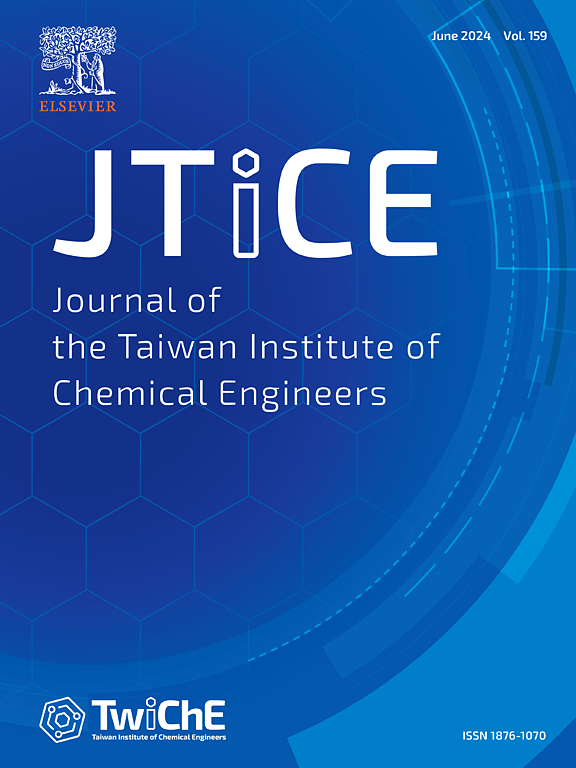Mn和Br共取代CsPbI3钙钛矿量子点用于白光发光二极管
IF 5.5
3区 工程技术
Q1 ENGINEERING, CHEMICAL
Journal of the Taiwan Institute of Chemical Engineers
Pub Date : 2025-04-15
DOI:10.1016/j.jtice.2025.106139
引用次数: 0
摘要
cspx₃钙钛矿量子点(PQDs)由于其优异的荧光性能和简单的合成工艺而引起了人们的广泛关注。然而,α-立方相CsPbI₃PQDs容易转变为不发光的δ-正交相,这对其在发光器件中的实际应用提出了重大挑战。方法采用热注入法制备了CsPbI₃红色量子点(PQDs),并在CsPbI₃晶格的b位和x位上共取代了Mn和Br。此外,从头算分子动力学(AIMD)模拟证实了CsMnₓPb₁₁ₓ(BrᵧI₁₁渍)₃PQDs在阳光照射下的鲁棒稳定性,证实了实验结果。重要发现CsMnₓPb₁₁ₓ(BryI₁₁ₓ)₃PQDs的PLQY为96.3%,在储存5个月后保留了87%的初始值。AIMD模拟结果表明,CsMnₓPb₁₃ₓ(BryI₁₃)体系发生了最小的结构变形,有效抑制了Pb二聚体的形成。此外,用于合成的(3-氨基丙基)三乙氧基硅烷(APTES)配体的硅基与正硅酸四甲基(TMOS)反应形成致密的二氧化硅(SiOₓ)包封壳。最后,用红色发光的CsMnₓPb₁₁ₓ(BrᵧI₁₁ᵧ)₃PQDs@SiOₓ、绿色发光的CsPbBr₃PQDs@SiOₓ和蓝色发光的基于ingan的芯片制造了一个白色发光二极管(WLED)。WLED显示CIE 1931色度坐标为(0.337,0.336),色域覆盖了NTSC标准的128%。本文章由计算机程序翻译,如有差异,请以英文原文为准。

Mn and Br co-substitution CsPbI3 perovskite quantum dots used for white light-emitting diodes
Background
CsPX₃ perovskite quantum dots (PQDs) have garnered considerable research interest due to their excellent fluorescent properties and simple synthesis process. However, the α-cubic phase CsPbI₃ PQDs are prone to transforming into the non-luminescent δ-orthorhombic phase, which poses a significant challenge to their practical application in light-emitting devices.
Method
In this study, red-emitting CsPbI₃ quantum dots (PQDs) were synthesized via the hot-injection method, with Mn and Br co-substituted at the B-site and X-site of the CsPbI₃ lattice. Furthermore, ab initio molecular dynamics (AIMD) simulations confirmed the robust stability of CsMnₓPb₁₋ₓ(BrᵧI₁₋y)₃ PQDs under sunlight exposure, corroborating the experimental findings.
Significant findings
The CsMnₓPb₁₋ₓ(BryI₁₋y)₃ PQDs exhibited a PLQY of 96.3 %, retaining 87 % of their initial value after five months of storage. AIMD simulations revealed that the CsMnₓPb₁₋ₓ(BryI₁₋y)₃ system underwent minimal structural deformation and effectively suppressed Pb dimer formation. Furthermore, the silyl group of the (3-aminopropyl)triethoxysilane (APTES) ligand used in the synthesis reacted with tetramethyl orthosilicate (TMOS) to form a dense silica (SiOₓ) encapsulation shell. Finally, a white light-emitting diode (WLED) was fabricated using red-emitting CsMnₓPb₁₋ₓ(BrᵧI₁₋ᵧ)₃ PQDs@SiOₓ, green-emitting CsPbBr₃ PQDs@SiOₓ, and a blue-emitting InGaN-based chip. The WLED exhibited CIE 1931 chromaticity coordinates of (0.337, 0.336) and achieved a color gamut covering nearly 128 % of the NTSC standard.
求助全文
通过发布文献求助,成功后即可免费获取论文全文。
去求助
来源期刊
CiteScore
9.10
自引率
14.00%
发文量
362
审稿时长
35 days
期刊介绍:
Journal of the Taiwan Institute of Chemical Engineers (formerly known as Journal of the Chinese Institute of Chemical Engineers) publishes original works, from fundamental principles to practical applications, in the broad field of chemical engineering with special focus on three aspects: Chemical and Biomolecular Science and Technology, Energy and Environmental Science and Technology, and Materials Science and Technology. Authors should choose for their manuscript an appropriate aspect section and a few related classifications when submitting to the journal online.

 求助内容:
求助内容: 应助结果提醒方式:
应助结果提醒方式:


